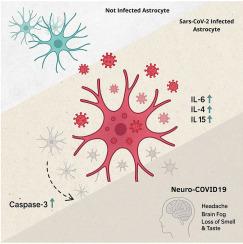星形胶质细胞介导的神经炎症是COVID-19患者神经系统预后的假设机制?来自一群巴西人的见解
IF 3.5
Q2 IMMUNOLOGY
引用次数: 0
摘要
神经系统covid -19已成为一个重大的全球健康问题,呈现出广泛的神经系统表现,包括头痛、脑雾和嗅觉缺失。尽管越来越多的证据表明,SARS-CoV-2感染会损害中枢神经系统(CNS)的功能,但这些影响背后的确切过程仍不完全清楚。尽管神经元已被广泛研究,但星形胶质细胞——大脑内稳态的关键调节因子——在这一背景下却在很大程度上被忽视了。在本研究中,我们将星形胶质细胞定位为神经covid -19神经病理景观的核心参与者,挑战其传统的支持作用。我们评估了巴西COVID-19患者队列中常见的神经系统症状,并研究了皮质星形胶质细胞的SARS-CoV-2感染是否会诱发神经炎症、谷氨酸能失衡、血管调节紊乱和细胞凋亡等可能的致病过程。在162例新冠病毒阳性患者中,头痛(53.09%)、脑雾(42.15%)和嗅觉缺失(38.72%)是最常见的症状。利用人诱导多能干细胞(hiPSC)衍生的星形胶质细胞,我们发现SARS-CoV-2感染可促进明显的促炎反应,培养上清中IL-6、IL-15和IL-4水平升高就是证据。受感染的星形胶质细胞也显示出分别参与血管舒张和谷氨酸清除的关键基因KLK1和EAAT1 mRNA表达降低。此外,分裂的caspase-3阳性细胞的显著增加表明细胞凋亡增强。总体而言,这些发现表明,SARS-CoV-2破坏星形胶质细胞稳态功能,导致神经炎症、兴奋性神经传递失调和细胞死亡,这可能是COVID-19神经系统后遗症的假设基础。通过将星形胶质细胞重新定义为活跃的主角,本研究强调了它们在中枢神经系统脆弱性中的重要作用。它还为未来研究开发针对COVID-19神经系统并发症的疗法提供了潜在目标。本文章由计算机程序翻译,如有差异,请以英文原文为准。

Astroglia-mediated neuroinflammation as a putative mechanism of neurological outcomes in COVID-19? Insights from a Brazilian cohort
NeuroCOVID-19 has emerged as a significant global health concern, presenting a wide spectrum of neurological manifestations, including headaches, brain fog and anosmia. While mounting evidence indicates that SARS-CoV-2 infection compromises central nervous system (CNS) function, the precise processes underlying these effects remain incompletely understood. Although neurons have been extensively studied, astrocytes – critical regulators of brain homeostasis - have been largely overlooked in this context. In this study, we position astrocytes as central players in the neuropathological landscape of neuroCOVID-19, challenging their traditionally supportive role. We evaluated the frequent neurological symptoms in a Brazilian cohort of COVID-19 patients and investigated whether SARS-CoV-2 infection of cortical astrocytes induces neuroinflammation, glutamatergic imbalance, vasoregulatory disruption, and apoptosis as likely pathogenic processes. Among 162 COVID-19-positive patients, headache (53.09 %), brain fog (42.15 %), and anosmia (38.72 %) were the most commonly reported symptoms. Using human-induced pluripotent stem cell (hiPSC)-derived astrocytes, we found that SARS-CoV-2 infection promotes a pronounced pro-inflammatory response, evidenced by elevated levels of IL-6, IL-15, and IL-4 in the culture supernatant. Infected astrocytes also showed reduced mRNA expression of KLK1 and EAAT1, key genes involved in vasodilation and glutamate clearance, respectively. Additionally, a significant increase in cleaved caspase-3-positive cells indicated enhanced apoptosis. Overall, these findings demonstrate that SARS-CoV-2 disrupts astrocyte homeostatic functions, leading to neuroinflammation, excitatory neurotransmission dysregulation, and cell death that may, hypothetically, underlie the neurological sequelae of COVID-19. By reframing astrocytes as active protagonists, this study highlights their essential role in CNS vulnerability. It also suggests potential targets for the future investigation in the development of therapies against the neurological complications of COVID-19.
求助全文
通过发布文献求助,成功后即可免费获取论文全文。
去求助
来源期刊

Brain, behavior, & immunity - health
Biological Psychiatry, Behavioral Neuroscience
CiteScore
8.50
自引率
0.00%
发文量
0
审稿时长
97 days
 求助内容:
求助内容: 应助结果提醒方式:
应助结果提醒方式:


